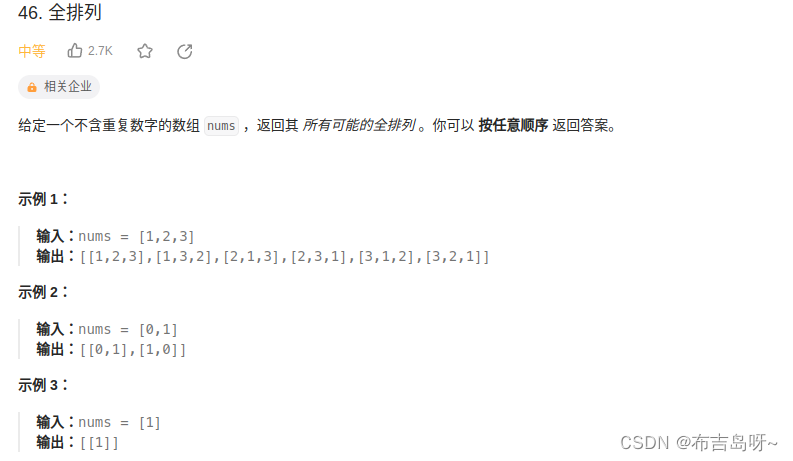1--全排列(46)

主要思路1:
经典全排列,每次枚举每一位时,重头开始枚举,用一个访问数组记录当前已经被访问过的数字;
这道题不包含重复数字,所以不需要进行树层上的剪枝;
#include <iostream>
#include <vector>
class Solution {
public:
std::vector<std::vector<int>> permute(std::vector<int>& nums) {
if(nums.size() == 0) return res;
std::vector<bool> vis(nums.size(), false);
std::vector<int> tmp;
dfs(nums, vis, tmp);
return res;
}
void dfs(std::vector<int>& nums, std::vector<bool>& vis, std::vector<int> &tmp){
if(tmp.size() == nums.size()){
res.push_back(tmp);
return;
}
for(int i = 0; i < nums.size(); i++){
if(vis[i] == true) continue;
tmp.push_back(nums[i]);
vis[i] = true;
dfs(nums, vis, tmp);
// 回溯
tmp.pop_back();
vis[i] = false;
}
}
private:
std::vector<std::vector<int>> res;
};
int main(int argc, char *argv[]){
std::vector<int> test = {1,2,3};
Solution S1;
std::vector<std::vector<int>> res = S1.permute(test);
for(auto v : res){
for(auto i : v) std::cout << i << " ";
std::cout << std::endl;
}
}
主要思路2:
可以利用下一个排列的思想来枚举全排列,首先需要将数组进行从小到大排序,然后不断求解下一个排列,一个下一个排列就是一个新的排列,直到最大的排列为止;
#include <iostream>
#include <vector>
#include <algorithm>
class Solution {
public:
std::vector<std::vector<int>> permute(std::vector<int>& nums) {
if(nums.size() == 0) return res;
std::sort(nums.begin(), nums.end()); // 从小到大排列
res.push_back(nums); // 记录最小的排列
while(nextp(nums)){
res.push_back(nums);
}
return res;
}
bool nextp(std::vector<int>& nums){
int n = nums.size();
// 找到第一个顺序对
int i;
for(i = n - 2; i >= 0; i--){
if(nums[i] < nums[i+1]) break;
}
if(i == -1) return false; //已经是最大排列了
// 找到一个nums[j] > 上面的nums[i]
int j;
for(j = n - 1; j > i; j--){
if(nums[j] > nums[i]) break;
}
// 交换nums[i] 和 nums[j]
std::swap(nums[i], nums[j]);
// 反转num[i+1] ~ nums.end()
std::reverse(nums.begin() + i + 1, nums.end());
return true;
}
private:
std::vector<std::vector<int>> res;
};
int main(int argc, char *argv[]){
std::vector<int> test = {1,2,3};
Solution S1;
std::vector<std::vector<int>> res = S1.permute(test);
for(auto v : res){
for(auto i : v) std::cout << i << " ";
std::cout << std::endl;
}
}
2--旋转图像(48)

主要思路:
按层(圈)来旋转,对于坐标为(r, c)的值,其旋转后的坐标为(c, n - 1 - r),且每四个(上,右,下,左)为一个循环节,循环交换循环节中四个元素即可,视频讲解参考:旋转图像
#include <iostream>
#include <vector>
#include <algorithm>
class Solution {
public:
void rotate(std::vector<std::vector<int>>& matrix) {
int n = matrix.size();
// 按层(圈)处理
for(int L = n; L > 0; L -= 2){
// 左上角起始元素
int row = (n - L) / 2;
int col = row;
// 当前这一行,顶行的前 L-1 个元素
for(int k = 0; k < L - 1; k++){
// 当前元素
int r = row, c = col + k;
int tmp = matrix[r][c];
// 从(r, c)开始寻找循环节,循环节的长度一定是4
for(int i = 0; i < 4; i++){
// 旋转后的坐标
int rr = c;
int cc = n - 1 - r;
// 旋转
std::swap(tmp, matrix[rr][cc]);
r = rr;
c = cc;
}
}
}
}
};
int main(int argc, char *argv[]){
std::vector<std::vector<int>> test = {
{1,2,3}, {4,5,6}, {7,8,9}};
Solution S1;
S1.rotate(test);
for(auto v : test){
for(auto i : v) std::cout << i << " ";
std::cout << std::endl;
}
}3--字母异位词分组(49)
主要思路: